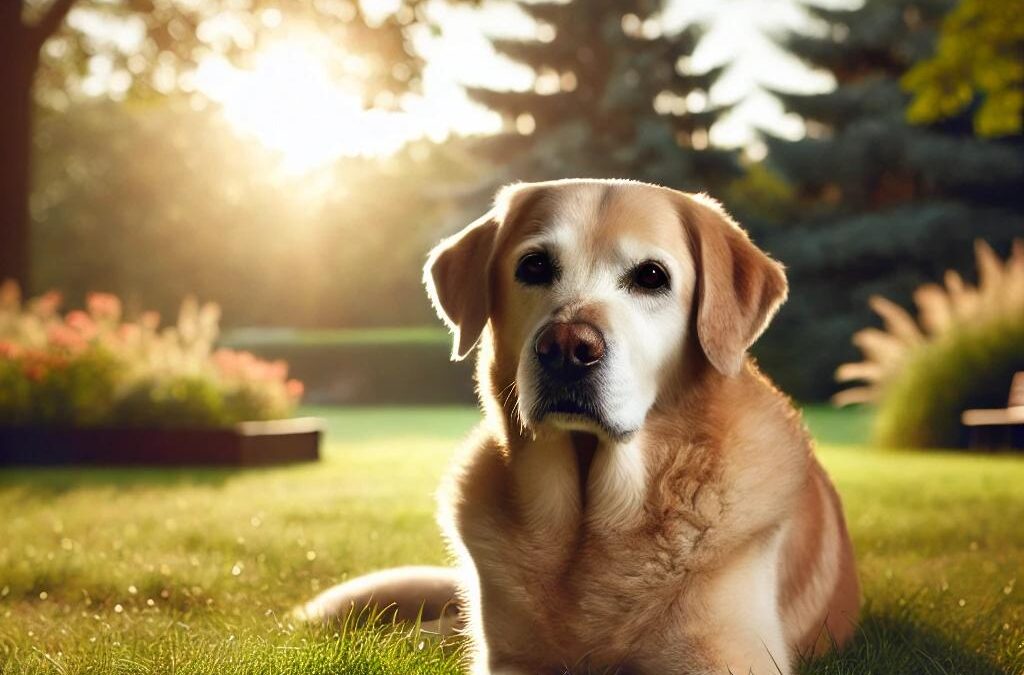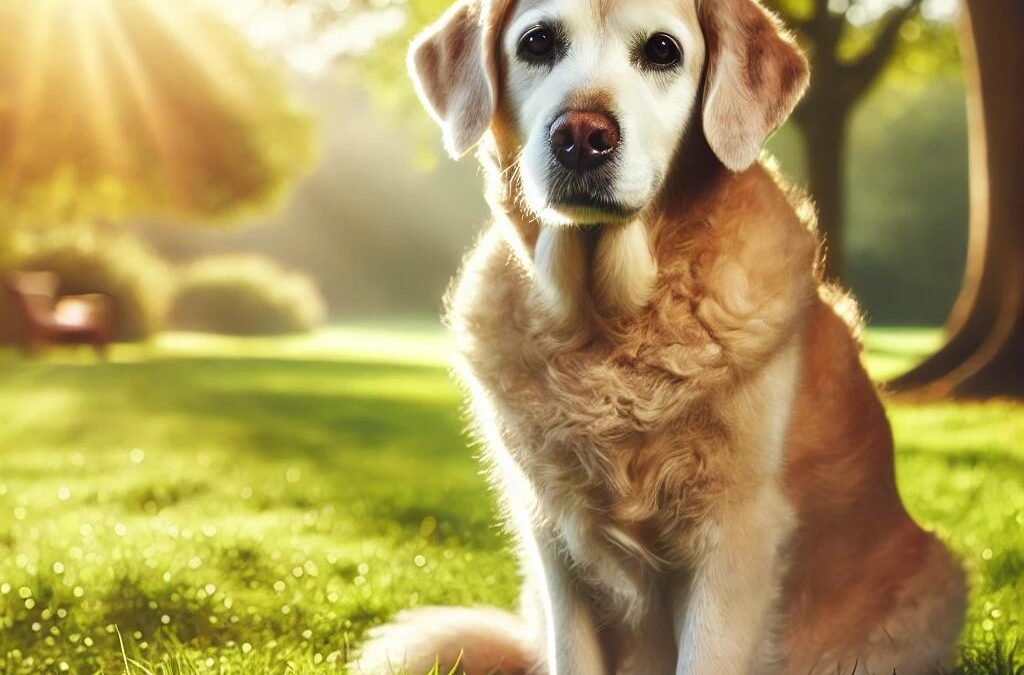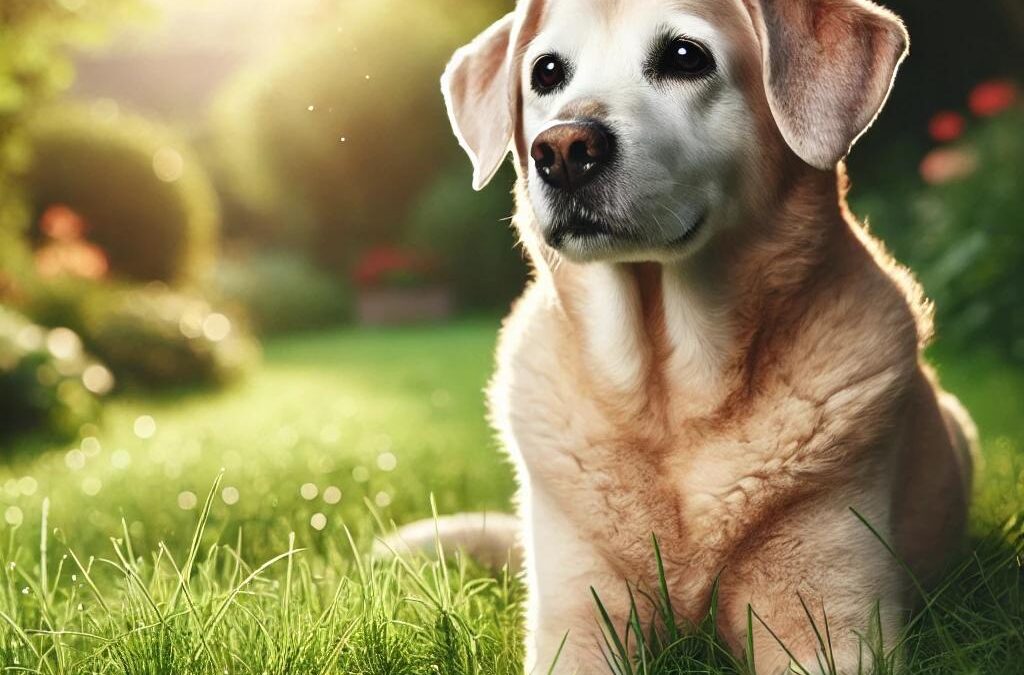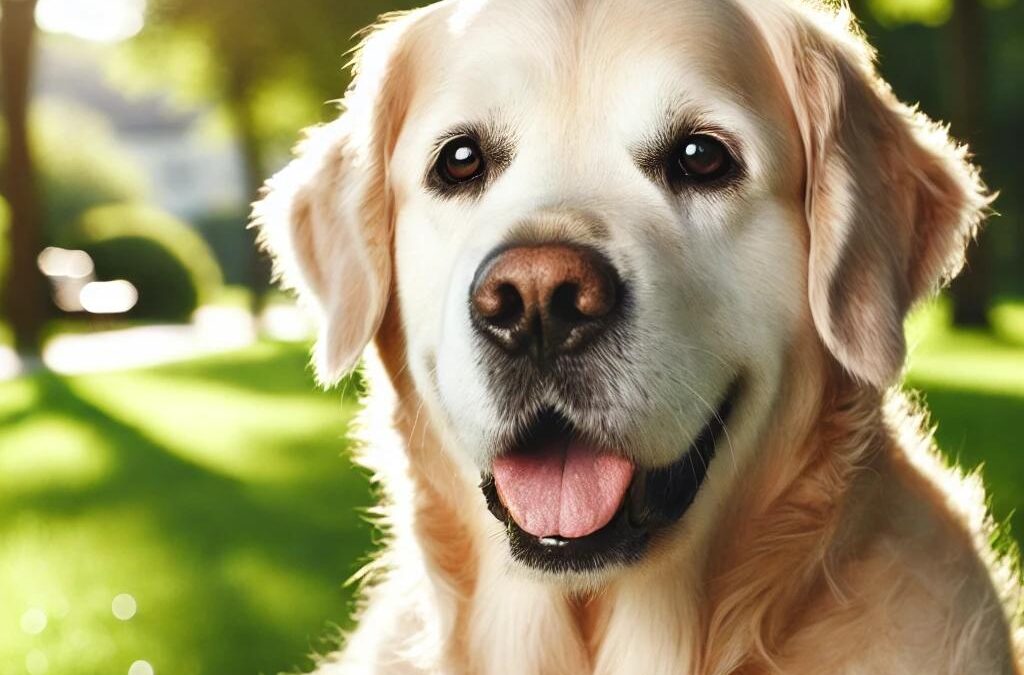
von TCMVET | 1. November 2024 | Krebs und Tumore bei Hunden
Hemangiosarcoma is a serious and aggressive cancer that affects dogs, with a high tendency to spread to other organs. This article outlines the prognosis for different types of hemangiosarcoma and offers insights into care strategies that may improve a dog’s quality of life.
Hemangiosarcoma Types and Their Prognosis
- Hämangiosarkom der Milz
Splenic hemangiosarcoma is one of the most common and aggressive types, occurring in the spleen. Without treatment, life expectancy is often limited to just a few weeks. Surgical removal of the spleen can extend survival to about 2–3 months. When combined with chemotherapy, some dogs may live up to 9 months. However, long-term survival is rare, with fewer than 10% surviving beyond one year.
- Cardiac Hemangiosarcoma
This type of hemangiosarcoma affects the heart, making it difficult to treat and typically resulting in a grave prognosis. Most dogs live only days to weeks without treatment. With palliative care and chemotherapy, survival may extend to around 4 months. However, cardiac hemangiosarcoma is generally incurable, and supportive care focuses on the dog’s comfort.
- Cutaneous Hemangiosarcoma
Cutaneous hemangiosarcoma, which affects the skin, has a relatively better prognosis. Tumors caused by UV exposure are less likely to metastasize, and dogs may live years if these tumors are removed promptly. Close monitoring of UV-exposed areas is essential, as recurrence can happen, and timely removal of new tumors is recommended.
- Subcutaneous Hemangiosarcoma
Located just below the skin, subcutaneous hemangiosarcoma has a poorer prognosis than cutaneous types because it can spread into deeper tissues. Even with treatment, survival may only be extended by a few months, depending on the tumor’s extent and response to treatment.
Treatment Options and Care Plans
For hemangiosarcoma, treatment can include surgery, chemotherapy, or a combination of approaches. Each has specific benefits and is chosen based on the tumor’s type, location, and progression.
- Operative Entfernung
Surgery may be an option for splenic and skin tumors. For splenic hemangiosarcoma, removal of the spleen is a common approach, often followed by chemotherapy to reduce the risk of recurrence.
- Chemotherapie
Chemotherapy can help slow down the tumor’s spread and improve survival times, especially for aggressive types like splenic and cardiac hemangiosarcoma. However, it’s crucial to weigh chemotherapy’s benefits and potential side effects with your veterinarian.
- Palliativpflege
Palliative care aims to enhance comfort and manage symptoms in dogs with advanced hemangiosarcoma. This may involve pain management, supportive therapies, and lifestyle adjustments to help the dog enjoy a better quality of life.
Überwachung und Follow-up
Regular follow-up visits with the veterinarian are vital for tracking the progression of hemangiosarcoma. These visits may include bloodwork and diagnostic imaging to detect any changes or potential metastasis. Keeping a close watch on your dog’s health and communicating with your veterinarian will help tailor care to the dog’s needs.
Verbesserung der Lebensqualität
While the prognosis for hemangiosarcoma remains challenging, pet owners can take proactive steps to enhance their dog’s quality of life. Balanced nutrition, gentle exercise, and creating a calm environment can positively impact a dog’s well-being. Working closely with the veterinarian to adapt the treatment plan as the disease progresses is key to ensuring that the dog remains as comfortable as possible.

von TCMVET | 1. November 2024 | Krebs und Tumore bei Hunden
Diagnosing skin tumors in dogs often begins with a procedure known as a fine needle aspirate (FNA). This minimally invasive test allows veterinarians to collect a small sample of cells from a suspicious growth. However, some tumors, especially those that are blood-filled like hemangiosarcomas, may require additional testing for a definitive diagnosis.
Understanding the Fine Needle Aspirate (FNA) Procedure
The FNA test is commonly the first diagnostic step when a skin tumor is suspected. The veterinarian uses a thin needle to extract a small cell sample from the tumor, which is then placed on a slide and examined under a microscope. The advantage of FNA is that it’s a quick, low-risk procedure that provides immediate insight into the tumor’s nature.
However, not all tumors are easily diagnosed with FNA. For example, hemangiosarcomas, which are blood-filled tumors, often yield non-diagnostic results. These samples can consist mostly of blood, with few tumor cells to analyze, making it challenging for veterinarians to draw definitive conclusions from an FNA alone.
When Further Testing is Necessary: The Role of Biopsies
When an FNA does not provide enough information, particularly in cases of suspected hemangiosarcoma, a surgical biopsy may be required. A biopsy involves the removal of a larger tissue sample from the tumor, which is sent to a lab for detailed analysis. Unlike FNA, a biopsy allows pathologists to examine the tumor’s cellular structure more thoroughly, providing a more accurate diagnosis. This additional step is critical for identifying aggressive tumors like cutaneous or subcutaneous hemangiosarcomas.
Why Accurate Diagnosis Matters
Determining whether a skin tumor is benign or malignant is essential for guiding treatment. Benign tumors may only require monitoring, while malignant tumors often call for prompt treatment. For example, hemangiosarcomas are aggressive and can spread to other organs if not treated quickly. By accurately diagnosing the tumor type, veterinarians can develop a targeted treatment plan that improves the dog’s quality of life and potentially extends survival time.
Understanding the diagnostic process for skin tumors in dogs can help pet owners make informed decisions about their pet’s health. While the FNA is a useful first step, a surgical biopsy may sometimes be necessary to reach a definitive diagnosis, especially with challenging tumor types like hemangiosarcomas. If you notice any unusual growths on your dog’s skin, consult your veterinarian for an evaluation as early as possible.

von TCMVET | 1. November 2024 | Krebs und Tumore bei Hunden
Wenn bei einem Hund ein Herztumor diagnostiziert wird, ist eine kontinuierliche Überwachung unerlässlich, insbesondere wenn Chemotherapeutika wie Doxorubicin Teil der Behandlung sind. Regelmäßige Nachuntersuchungen helfen sicherzustellen, dass etwaige Nebenwirkungen frühzeitig erkannt und wirksam behandelt werden, um die Lebensqualität Ihres Hundes zu verbessern.
Die Bedeutung von Herz-Ultraschall während der Behandlung
Ihr Tierarzt wird Ihnen wahrscheinlich im Rahmen der Nachsorge Ihres Hundes regelmäßige Herzultraschalluntersuchungen empfehlen. Diese Ultraschalluntersuchungen sind nicht invasiv und liefern wichtige Erkenntnisse über die Herzgesundheit Ihres Hundes. Sie ermöglichen es dem Veterinärteam, den Tumorstatus zu überwachen, die Funktion des Herzmuskels zu beurteilen und frühe Anzeichen einer Arzneimitteltoxizität zu erkennen, insbesondere wenn Doxorubicin verschrieben wird.
Doxorubicin ist ein starkes Chemotherapeutikum, das häufig zur Behandlung aggressiver Krebsarten eingesetzt wird. Eine bekannte Nebenwirkung dieses Medikaments ist jedoch, dass es den Herzmuskel schädigen kann. Eine frühzeitige Erkennung jeglicher Herzveränderungen durch Ultraschall kann dem Tierarzt helfen, den Behandlungsplan rechtzeitig anzupassen, um die Risiken zu minimieren.
Die Rolle von Röntgenaufnahmen des Brustkorbs bei der Überwachung der Krebsausbreitung
Neben Herzultraschall sind Röntgenaufnahmen des Brustkorbs ein weiterer wichtiger Bestandteil der Nachsorge. Bei jedem Besuch wird Ihr Tierarzt Röntgenaufnahmen des Brustkorbs machen, um festzustellen, ob sich der Tumor über das Herz hinaus ausgebreitet hat. Diese Bilder helfen dabei, Metastasen frühzeitig zu erkennen und können umgehend eingreifen.
Bei bösartigen Tumoren ist das Risiko einer Metastasierung höher. Daher ist eine regelmäßige Bildgebung ein wichtiger Bestandteil der Gesundheit Ihres Hundes. Wenn Sie eine Ausbreitung auf andere Körperteile frühzeitig erkennen, stehen Ihnen mehr Behandlungsmöglichkeiten zur Verfügung und Sie können möglicherweise die Zeit verlängern, die Ihnen Ihr Haustier noch bleibt.
Der Einfluss von Doxorubicin auf die Herzgesundheit
Obwohl Doxorubicin bei vielen Krebsarten wirksam ist, muss seine Anwendung engmaschig überwacht werden, da es das Herzmuskelgewebe schwächen oder schädigen kann. Regelmäßige Ultraschalluntersuchungen helfen dem Veterinärteam, frühe Anzeichen von Toxizität zu erkennen, was insbesondere bei der Dosierungsanpassung oder der Prüfung alternativer Behandlungsmöglichkeiten hilfreich sein kann.
Prognose bei bösartigen Herztumoren verstehen
Die Prognose für Hunde mit bösartigen Herzmuskeltumoren ist aufgrund der aggressiven Natur dieser Tumore und des Metastasierungspotenzials oft vorsichtig bis schlecht. Dennoch können Sie mit konsequenter Nachsorge und frühzeitiger Erkennung von Komplikationen gemeinsam mit Ihrem Tierarzt die bestmögliche Versorgung Ihres Hundes gewährleisten.
Unterstützen Sie die Gesundheit Ihres Hundes während der Behandlung
Neben medizinischen Nachuntersuchungen kann die Aufrechterhaltung eines gesunden Lebensstils Ihres Hundes durch ausgewogene Ernährung, moderate Bewegung und Stressbewältigung dazu beitragen, seine Widerstandsfähigkeit während der Behandlung zu stärken. Die Kommunikation mit Ihrem Tierarzt ist wichtig, um Veränderungen im Gesundheitszustand Ihres Hundes zu verstehen und die Pflege bei Bedarf anzupassen.

von TCMVET | 1. November 2024 | Krebs und Tumore bei Hunden
Herztumore bei Hunden sind zwar selten, aber Tierbesitzer sollten sich ihrer bewusst sein, insbesondere wenn die Hunde älter werden. Diese Tumore, die sich im oder um das Herz herum bilden, können in Art und Schwere variieren. Wenn Tierbesitzer die verschiedenen Tumorarten und ihre möglichen Auswirkungen kennen, können sie rechtzeitig tierärztliche Hilfe in Anspruch nehmen und die Gesundheit ihres Hundes effektiv überwachen.
Häufige Arten von Herztumoren bei Hunden
Herztumoren können eingeteilt werden in Primärtumoren, die im Herzen selbst entstehen, und Sekundärtumoren, die sich von anderen Körperteilen zum Herzen ausbreiten.
- Primäre Herztumoren
Primäre Herztumoren entstehen direkt in den Strukturen des Herzens, häufig im Herzmuskel, in den Blutgefäßen oder im Bindegewebe.- Hämangiosarkome
Dabei handelt es sich um einen schnell wachsenden bösartigen Tumor, der von den Blutgefäßen im Herzen ausgeht. Er ist aggressiv und hat ein hohes Metastasierungspotenzial, sodass oft ein sofortiger Eingriff erforderlich ist.
- Fibrome und Fibrosarkome
Tumoren, die sich aus Bindegewebe entwickeln, wie es in den Herzklappen vorkommt, werden als Fibrome bezeichnet, wenn sie gutartig sind, und als Fibrosarkome, wenn sie bösartig sind. Fibrosarkome sind invasiver und breiten sich möglicherweise auf umliegende Organe aus.
- Myxome und Myxosarkome
Myxome sind gutartige Tumoren, die in den oberen Herzkammern (Vorhöfen) vorkommen. Wenn sie bösartig sind, werden sie als Myxosarkome bezeichnet und haben eine höhere Wahrscheinlichkeit, sich auszubreiten und die gesamte Herzfunktion des Hundes zu beeinträchtigen.
- Rhabdomyosarkome
Rhabdomyosarkome sind eine seltenere Tumorform, die im Skelettmuskelgewebe des Herzens entsteht. Sie sind immer bösartig und können erhebliche Herzkomplikationen verursachen.
- Sekundäre Herztumoren
Sekundäre Herztumoren gelangen durch Metastasierung aus anderen Bereichen ins Herz. Dazu gehören:- Lymphome
Lymphome sind bösartige Tumoren, die aus den Lymphknoten entstehen und schließlich das Herz befallen können, was zu Beeinträchtigungen der Herzgesundheit führen kann.
- Neurofibrome
Neurofibrome sind gutartige Tumoren, die aus Nervenfasern entstehen und das Herzgewebe befallen können, ohne sich auszubreiten. Je nach Lage können sie jedoch dennoch die Herzfunktion beeinträchtigen.
- Granularzelltumoren
Diese Tumoren können gutartig oder bösartig sein und beeinträchtigen häufig das Herz sekundär. Ihr Ursprung ist unklar, wodurch ihr Verhalten im Körper unvorhersehbar ist.
- Osteosarkome
Bösartige Knochentumore wie Osteosarkome können ins Herz metastasieren und stellen aufgrund ihrer aggressiven Ausbreitung ein ernstes Gesundheitsrisiko dar.
Die Symptome erkennen
Herztumore bei Hunden können aufgrund ihrer inneren Natur und manchmal nur leichten Symptomen im Frühstadium schwierig zu erkennen sein. Häufige Anzeichen sind Lethargie, Atembeschwerden, Ohnmacht und unregelmäßiger Herzschlag. Da sich diese Symptome mit anderen Erkrankungen überschneiden, ist für eine genaue Diagnose eine tierärztliche Untersuchung erforderlich.
Diagnose und Pflegetipps
Zur Diagnose werden häufig moderne bildgebende Verfahren wie Ultraschall, MRT oder CT-Scans eingesetzt, um den Zustand des Herzens zu beurteilen. Zur Bestätigung des Tumortyps können auch Blutuntersuchungen und Gewebebiopsien erforderlich sein.
Die Pflege eines Hundes mit einem Herztumor umfasst regelmäßige Überwachung und unterstützende Pflege, insbesondere in Fällen, in denen Behandlungsmöglichkeiten wie Operation, Bestrahlung oder Chemotherapie nicht möglich sind. Eine Ernährungsunterstützung, leichte Bewegung und eine ruhige Umgebung können dazu beitragen, die Lebensqualität eines Hundes zu verbessern.
Die Prognose für Hunde mit Herztumoren hängt von Faktoren wie Tumorart, -ort und allgemeinem Gesundheitszustand ab. Während einige gutartige Tumoren ohne Eingriff behandelt werden können, ist die Prognose bei bösartigen Tumoren oft vorsichtig. Dennoch können eine frühzeitige Erkennung und unterstützende Pflege das Wohlbefinden und die Lebensdauer eines Hundes verlängern.

von TCMVET | 30. Oktober 2024 | Krebs und Tumore bei Hunden
Iridociliary cysts, also known as iris or uveal cysts, are benign fluid-filled sacs that develop within the eye. While typically harmless, these cysts may occasionally grow large enough to affect vision or eye function. Both congenital and acquired cysts can occur in dogs, with certain breeds more prone to developing them due to genetic factors. This article explores the causes, symptoms, and breed-specific risks associated with iridociliary cysts and offers tips on maintaining canine eye health.
What Are Iridociliary Cysts and How Do They Form?
Iridociliary cysts form within the eye and are generally classified into two types: congenital and acquired.
- Congenital Cysts
These cysts are present at birth, caused by developmental abnormalities in the eye. Genetic predisposition is often a factor, leading certain breeds to develop these cysts more commonly. These cysts are generally small and harmless but should be monitored in case they grow larger.
- Acquired Cysts
Acquired iridociliary cysts can develop later in life due to trauma or uveitis, an inflammation of the eye’s dark layers. In many cases, the exact cause of acquired cysts remains unknown, but eye injuries or underlying health issues can contribute to their formation.
Breed Tendencies and Iridociliary Cysts
Certain dog breeds are genetically predisposed to iridociliary cysts, including:
- Boston Terrier: Boston Terriers often develop these cysts due to genetic factors, making routine eye exams beneficial for early detection.
- Golden Retriever: Golden Retrievers are prone to a specific condition involving both iridociliary cysts and pigmentary uveitis. This combination can lead to vision issues and is sometimes linked to glaucoma.
- Labrador Retriever: Labrador Retrievers also have a tendency toward developing eye cysts, though generally less frequently than Golden Retrievers.
- Deutsche Doggen: Great Danes may develop glaucoma associated with iridociliary cysts, so regular monitoring is important for early intervention.
Recognizing Symptoms and Complications
In most cases, iridociliary cysts are benign and asymptomatic, but they may cause issues if they grow large:
- Visible Dark Spots in the Eye: Cysts may appear as dark, semi-transparent spots within the eye, visible during routine checks.
- Vision Interference: Larger cysts can obstruct the visual field, which may affect the dog’s ability to see clearly.
- Increased Risk of Glaucoma: In some breeds, iridociliary cysts are linked to glaucoma, characterized by increased pressure in the eye that can cause pain and lead to vision loss if untreated.
Veterinary Care and Treatment Options
Most iridociliary cysts do not require treatment. However, veterinary monitoring and eye exams are recommended for early detection, especially for high-risk breeds:
- Routine Eye Exams: Regular check-ups help monitor the size and position of cysts, ensuring they don’t cause complications.
- Operative Entfernung: If a cyst grows large enough to impair vision or cause discomfort, surgical removal may be recommended. This procedure is generally safe and can restore vision.
- Glaucoma Management: If glaucoma is present, medication or surgery may be necessary to relieve intraocular pressure and prevent further complications.
Eye Care Tips for Dogs Prone to Iridociliary Cysts
For dogs at higher risk of developing iridociliary cysts, proactive eye care is essential:
- Regelmäßige Kontrolluntersuchungen: Annual eye exams can detect any early changes, particularly in predisposed breeds.
- Monitor for Signs of Discomfort: Watch for squinting, tearing, or redness, as these may indicate irritation or other eye issues.
- Maintain Eye Hygiene: Gently clean around your dog’s eyes to prevent irritation, and avoid exposure to substances that could harm their eyes.
Managing and Monitoring Iridociliary Cysts in Dogs
While iridociliary cysts are usually benign, understanding their potential causes, breed tendencies, and symptoms can help pet owners take proactive steps. By maintaining regular eye check-ups and monitoring for any changes, you can support your dog’s eye health and address any issues early, helping them enjoy clear vision and comfort throughout their life.






